ASUS F2A85-V Pro Review: A Look at FM2 with A85X
by Ian Cutress on October 10, 2012 11:20 AM EST- Posted in
- Motherboards
- Asus
- Trinity
- FM2
- A85X
ASUS F2A85-V Pro BIOS
The ASUS BIOS is one that we have come to know and enjoy using, given its simplicity and ease-of-use. Over my tenure at AnandTech I must have covered at least ten different Intel based ASUS BIOSes, but only one ever AMD ASUS BIOS. Today we raise that figure to two with the F2A85-V Pro. Despite this, users of Intel based ASUS graphical BIOSes will not see much difference visually to the Intel counterparts.
In terms of performance, the only issues I really had with the BIOS were temperature readings and memory settings. The former is due to this weird thing that AMD processors seem to do – only show temperature values between 25C and 60C. In the operating system this means that even if you ramp up the voltage, all of the temperature reading software sees values in this range. Normally while overclocking I like to keep an eye on temperatures, in case they start hitting a limit. 60C is still fairly cool in overclocking scenarios, so I was surprised when I could keep ramping up the voltage with no discernable affect. It could be a case of other software needing to hook better into the temperature sensors, but even ASUS’ own temperature control was showing this. I personally found it a bit odd. Regarding memory settings, we have options to set from default all the way up to DDR3-2400 MHz, and the processor is rated up to DDR3-1866 by AMD specifications – the system would randomly decide if DDR3-2400 was stable during testing, and as a result some of the initial tests were at 2400, and the rest are at 2133. This is either indicative of the motherboard, or indicative of the memory controller in these processors not being geared to 2400 MHz (or I have a dud of a sample). The last thing about performance I would like to mention is our voltage readings in OCCT, which were fairly erratic. However I will cover that later in the review.
For the BIOS itself, our first screen presented is our easy mode:
This screen has the majority of what we want when a user opens a BIOS – the name of the motherboard being used, the BIOS version, the CPU installed (with speed), memory installed (with speed), voltage readings, temperature readings, fan speed readings and a boot priority order. I am very glad I have all of this to hand and it is easy to see. The additions I would suggest are by having some of the objects clickable to various advanced options located deeper in the BIOS – such as clicking on the ‘Fan Speed’ heading takes us to the fan speed selection. Now clearly ASUS’ way of showing a BIOS is different to that of other manufacturers that use an image of the motherboard as their front end BIOS screen and ask users to click on various parts to access settings. The main difference between the two is essentially whether the companies want to decide if the user is interfacing with a product or a system, and whether that company wants the user to recognize this fact or not. For an average user, obviously interfacing with the system as a whole makes much more sense – they are not too concerned if they are speaking with the motherboard, the CPU, the fan controllers or anything like that. Some enthusiasts however would prefer the acknowledgement that they are talking or manipulating component A or component B within a system. ASUS take this knowledge on board, and let the user interact with the whole of the product from the get-go without confusing users about where the SATA ports actually are.
The main screen in the BIOS is the AI Tweaker section, designed to help users overclock the processor. Our overclocking results are shown in our typical overclocking section, but it is important to note that for most overclocking scenarios for the user, all we need to do is adjust voltage and CPU frequency. In the F2A85-V Pro, our first option is to select what type of overclocking we want – Auto (none), Manual, or D.O.C.P. We have encountered D.O.C.P. before on AMD boards, and the quick explanation is ‘a BIOS hack to get XMP to work’. Remember that XMP is an Intel standard, so these motherboard manufacturers have worked out a way to parse that information in an AMD system. By selecting DOCP, the system will adjust the memory ratio, the APU frequency (if required) and the memory sub-timings/voltages to the XMP profile of the kit. In some circumstances this may produce a CPU overclock, so ensure that that CPU frequency is where you would want it as well.
Selecting Manual for our overclock gives us options to adjust the APU Frequency (i.e. the BUS speed / BCLK), the memory frequency, the APU multiplier, the NB Frequency, EPU Power saving modes, and the GPU frequency. Each option has an associated explanation on the right hand side telling the user of what the option does and what values are applicable. Underneath these settings are the ASUS OC Tuner (which applies a fast overclock), our DRAM timing screens, DIGI+ Power control and voltages.
The main voltages for the APU can be adjusted either by an offset or as an absolute value – the rest are changed via absolute values.
Shots of the Memory and DIGI+ sections:
Also in the BIOS are our advanced options which give access to the CPU, SATA, USB, NB and onboard devices. By default our SATA ports are on AHCI which is good, but it is also important to note that each USB port on board can be enabled and disabled through these options:
Fan controls are situated in the Monitor section of the BIOS, where this area also shows the important temperatures, fan speeds and voltages. Each of the fan headers on the F2A85-V Pro can be controlled independently, and ASUS give us the option of a low speed limit and a profile to select aggressiveness in the ramping of the fans. The OS software is a lot better to use for fan control than the OS options in this regard.
Also in the BIOS we have the EZ-Flash utility for updating the BIOS, SPD information to confirm the memory is the memory purchased, and an option to save up to eight OC profiles.


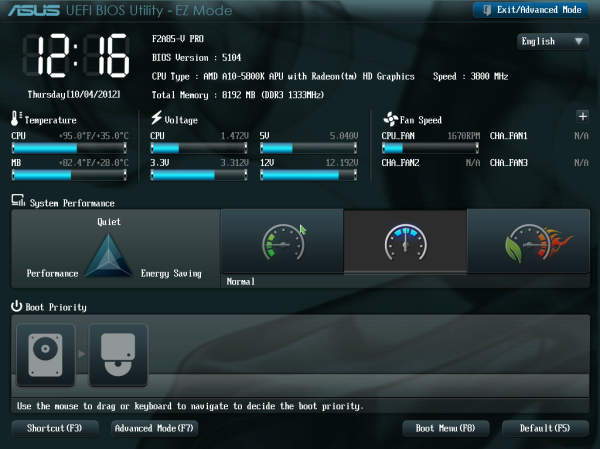
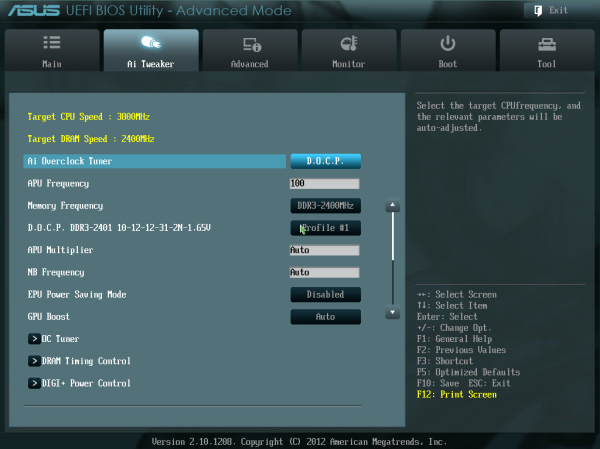
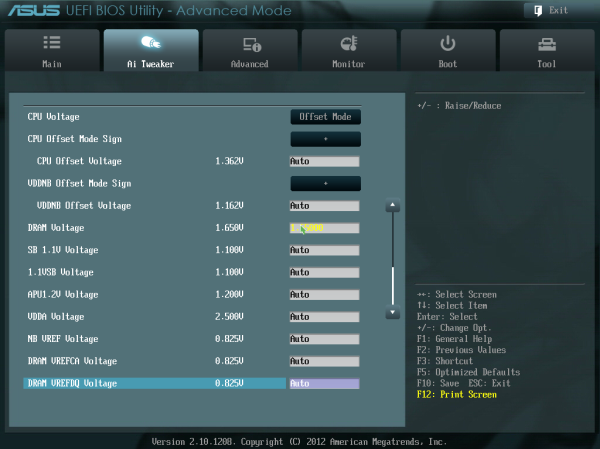
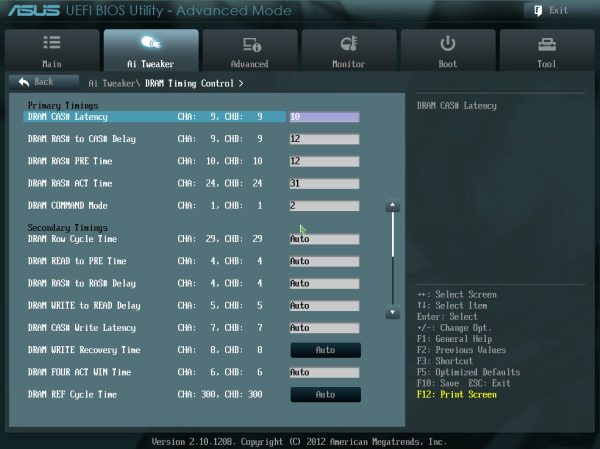
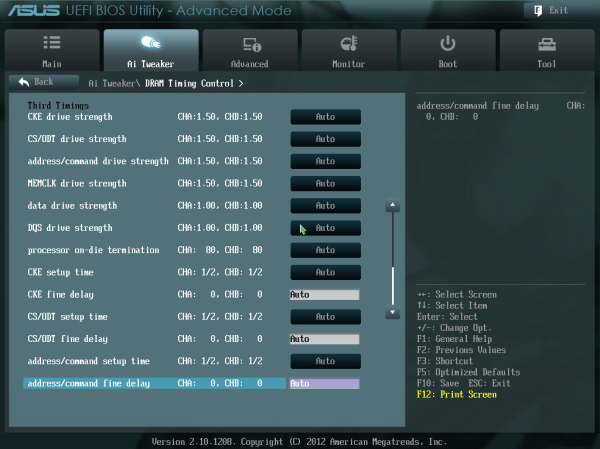
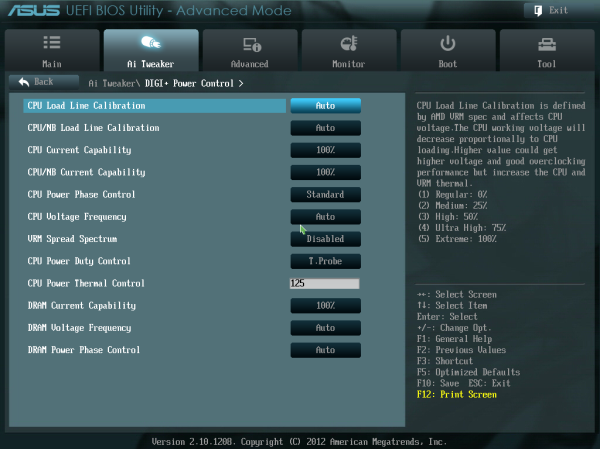
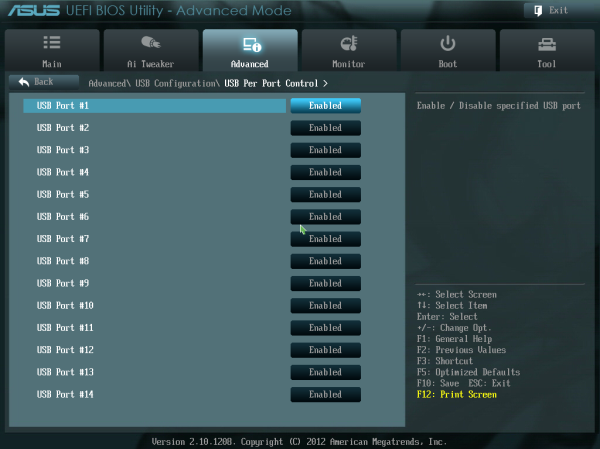
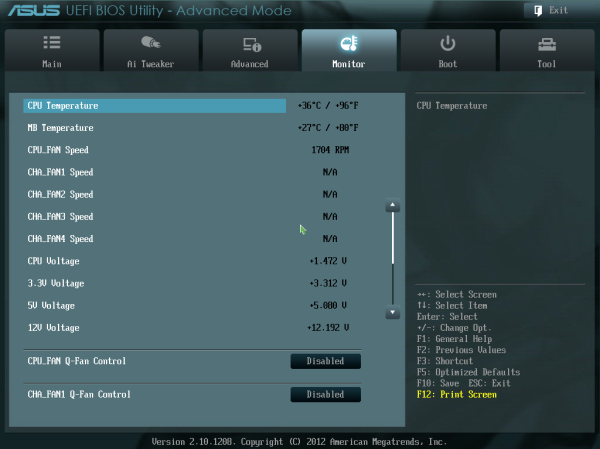
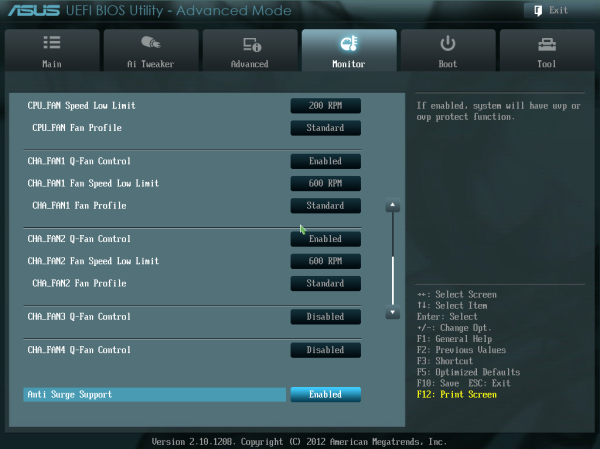
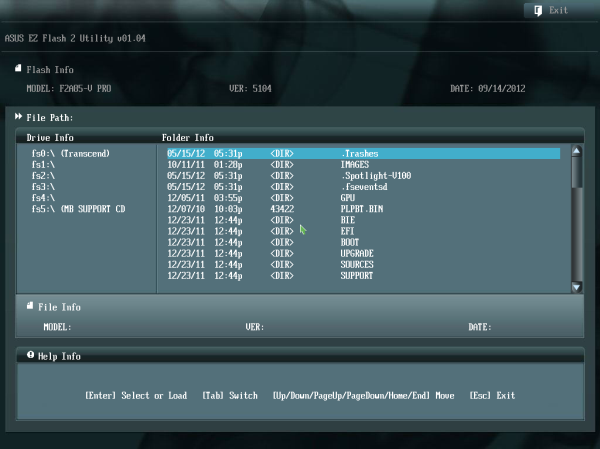














66 Comments
View All Comments
IanCutress - Wednesday, November 28, 2012 - link
1) Interestingly enough it is not a reviewers job to debug. I do correlate my results to the manufacturers, but I test on the latest publicly available BIOS at the time of testing. If I sat around waiting for 'the next BIOS' then each review would take 3x as long and I couldn't feed my family. Sorry to disappoint. (Also, not all reviewers are masculine as per your pronoun usage.)2) The USB 3.0 and SATA 6 Gbps are both native on Intel and AMD unless specified otherwise. I believe it is an appropriate comparison. People deciding to upgrade will want a comparison between what is available now in the market, not what was on the market. There is scope for editorials to look at how certain dynamics have changed over the years, but also tests change. My old data for 9xx chipsets is not relevant here.
3) Again, tests change over time in order to correlate with newer hardware and test the capabilities. If you have the spare time to dig out the hardware and run the newer tests, that's up to you. The other 14 motherboards I have in needed to be tested get priority here otherwise they become irrelevant. I would love to have infinite hardware and infinite time to do the comparisons, but that is not a logistical possibility.
4) Each chipset is tested against a single CPU. P67/Z68 was i5-2500K, X79 was i7-3960X, FM1 was A6-3650, FM2 was A10-5800K.
5) My apologies, next time I'll forgo the initial release review because it's the only board in my hand before release and wait a few months until I have six reviewed then post them at once when they become a little irrelevant.
6) Have you? Have you got time to do stability testing? What about testing it at high altitude, or in the Sahara?
If you believe there are things missing from the review, helpfully suggest additions for future consideration. My email is through my name on the review.
brookheather - Thursday, October 11, 2012 - link
Typo - "there is few reasons to jump on board to Trinity".Mugur - Friday, October 12, 2012 - link
Well, she was hot back in the first Matrix days... :-)silverblue - Thursday, October 11, 2012 - link
"With that being said, it is clear that video conversion is an INT process and all four of the A10-5800K INT units are being used"Are they, though? If so, it's a bit disappointing. Are all four threads maxed out in Task Manager? It'd be interesting to see a 4C/4T Intel processor thrown in there (2500K seems a perfect candidate) as well.
From looking at this, it should mean that an identically clocked Piledriver (83xx) CPU wouldn't be too far behind the 3770K in this one test. It does also mean, unfortunately, that even with linear performance scaling, even the top Piledriver CPU won't dethrone Thuban in the 3DPM MP test.
Soulnibbler - Thursday, October 11, 2012 - link
What does is this line in the performance section supposed to mean?QUOTE:
From a practical standpoint, the lack of floating point units in the CPU gives cause for concern as not everyone codes in hex or integer style (my own personal software all uses FP – INT would be confusing to code for me for negligible gain on most architectures).
/QUOTE:
I'm assuming you are referring to the bulldozer/steamroller architecture with a shared FPU unit per pair of integer units. On first reading it implies (and this implication is uncontested by the bizarre contents of of the following parentheses) that there is no floating point unit on the chip. That is patently wrong as there is a rather nice FPU shared between every two integer cores.
The other interpretation is that you think it needs MORE than half an FPU per core. That is an arguable point, but then the strange text in the parentheses paints you as someone who needs much more study towards what actually happens in a program. So much of your normal computing occurs in integer space. There isn't really any sort of program I can easily think of where you don't use integer operations (even memory mapping is integer) many times in order to prepare to do a single FP operation. The counter examples are all pretty much graphics examples where we want to work on vectors. The Trinity FPU has a nice vector processor too. If you break down and look at the machine code that any of your programs use you will find that an overwhelming (much greater than 66%) of that code is integer code.
Crying OH NOES 1/2 A FPU, is not good reporting. YES the AMD chips lag the Intel chips, YES the design parameters are different. The unfounded supposition that performance difference are due to that specific portion of the architectural choice is frankly bad journalism. If you want to make claims like that you have to point to a set of benchmarks that demonstrate clearly that the 1/2 FPUs are to blame. I doubt this is the case as most analysis that I've seen points to larger memory subsystem problems as a much bigger factor.
IanCutress - Wednesday, November 28, 2012 - link
If your supposition is true, then the A10-5800K should not experienced as much of a decrease against the competition as it did do in the results.My 3DPM results clear my position on the matter:
"In the single threaded test, a lot of conclusions can be drawn from the comparison of AMD architectures. Direct comparison of Piledriver to Bulldozer (A10-5800K to FX-8150) gives a boost in single core performance of 7%, however comparing the old Stars cores of the A8-3850 at 2.9 GHz is roughly the same as the new Piledriver core at 4.2 GHz. So even with a 1.3 GHz advantage, Piledriver is only as good as Stars and less efficient in floating point results. If we compare Piledriver to Thuban, i.e. A10-5800K to X6 1100T, the Piledriver core gets stomped on by a good 25% performance. I find this quite staggering – most of the code I ever encountered as a computational chemist was floating point based, dealing with single and double precision on a regular basis. On this result, I would steer clear of Piledriver.
The multithreaded version of 3DPM is slightly tougher to analyze. Due to the FP nature of the program, the A10-5800K is essentially a 2 core FPU processor, whereas all the other comparative AMD processors have either 4 or 6 FPUs to play with. What is perhaps worth considering is that the Bulldozer processor with 4 modules scores 326.32, whereas the Piledriver processor with only 2 modules scores 203.06, which is more than half. This would mean that the Piledriver core actually achieves 20% better performance at the same frequency, despite our ST test giving Piledriver only a 7% increase. Part of this could be put down to the architecture improvements – improved scheduling for heavily threaded loads, one of the downfalls of Bulldozer but was improved in Piledriver could be the reason here."
My basis for my comments is from a computational complexity standpoint. Sure memory mapping may be an int process, but if I only do it at the beginning and end of a matrix transformation (and thereby having a total processing time less than 0.1% of the program) then it becomes insignificant.
What AMD have done is project that applications in the future which require heavy computational throughput will be driven by INT ops. The big software vendors can do this, making video conversion and ray tracing type applications enhanced by use of INT ops. But for the non-CompSci scientist who relies more on readable code but also wants a speed increase, then going all out on the INT side may not be possible, and we get limited performance due to the scheduling and the lack of pure grunt due to the gutted APU. It's a design choice AMD have to live with, and I'm not the only one who is not entirely in favor of it.
Scootiep7 - Thursday, October 11, 2012 - link
Ok, I'm trying not to break down and just buy a Llano for my HTPC build, but does anybody know how much longer it'll be till I can get some nice options for a mini-ITX such as http://news.softpedia.com/news/MSI-Presents-FM2-A7... and the 5700k? What's the holdup on these!groundhogdaze - Thursday, October 11, 2012 - link
AMD should play to their strengths which is an affordable CPU with a relatively fast integrated GPU. That means focusing a small form factor systems such as AIO, ITX, HTPC class systems, however, I am surprised and disappointed at the relative lack of options when it comes to ITX FMx motherboards. I sold my AMD stock when I concluded they had their strategy wrong. Most folks who want to use a full sized case would also want to use a dedicated GPU, otherwise, what's the point of having a full sized case? Wrong marketing choice.Unless AMD can improve their heat/power ratings, the Intel G530 makes better sense as a NAS solution as it is dirt cheap and uses less power than its advertised 65w TDP while running circles around the Atom class processors. I hope AMD is reading the forums and best luck to them.
Mugur - Friday, October 12, 2012 - link
You are right. Full ATX and Trinity makes little sense. mATX and mini ITX with 8 SATA3 and integrated graphics should be the focus. Full ATX in fact makes little sense today, anyway... :-)If you want more than a NAS from a server, the best 65W Trinity part should be nice. I have a Phenom II X2 rated 80W in my HTPC and an Athlon II X4 (95W) in my server at home. Neither of them comes even closer to their rated TDP, according to the "green" ICs and software of the motherboards (Gigabyte and Asus).
silverblue - Friday, October 12, 2012 - link
AMD seems to volt their processors conservatively, so K10Stat (or other utilities) or using the BIOS to reduce the voltage may prove useful in reducing power consumption noticably without affecting performance more than a couple of percent.Toms ran an article on this as regards Trinity, and have done so with various AMD models in the past:
http://www.tomshardware.com/reviews/a10-5800k-trin...
Saving 14W for a tiny performance deficit is more than acceptable in my eyes.
I undervolted my Phenom II X3 710 as per the following article:
http://www.tomshardware.com/reviews/processor-powe...
(though I needed to raise voltages by 0.025v to keep it 100% stable in my case)